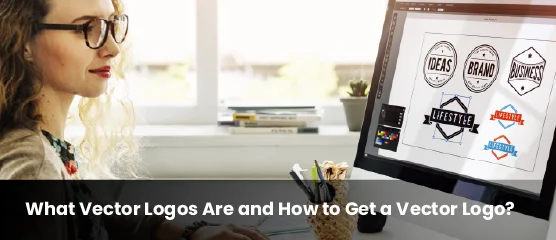
In this generation, a solid online presence is essential for any business to grow. Choosing the correct logo format is important. This decides your future brand reputation. With a wide variety, it isn't easy to choose the right one.
Remember that your logo showcases the brand value, mission, quality of product, and crucial elements of the brand. Not all logos hold the same number of steps, so understanding the importance of vector logos is essential to maintaining your professional virtual identity. It's easier to get lost in the production stages if you are unaware of the intricacies, which may lead to wrong decisions.
A vector logo can be your life-saver in almost any situation. But wait, what is a vector logo, and why do you need it?
Let's explore together and find the basic principles that could help us create a unique logo.
Vector logos consist of points, dots, lines, and various shapes. Unlike raster graphics, it's based on mathematical equations. They don't lose their quality in the process. You can always edit vector logo files without experiencing any mess. This plays a fundamental role in the logo's quality and flexibility.
Professional logo makers always prefer a secure and scalable format for logo creation. This is where vector logo comes to the rescue, where resizing takes a moment to meet the business's operational needs. Adobe Illustrator is the most commonly used tool to edit vector files, well-known for its easy-to-use functionality.
It's always recommended to save your file in vector format as you may need to edit it for various platforms and purposes in the future. Vector files maintain their quality during conversions; that's why it's always the number one preference of experts.
Key Characteristics of Vector Logos:
Vector logos specialize in their quality, regardless of their size. It will always look perfect whether you place the logo on a sign or business card.
Vector logos specialize in their quality, regardless of their size. It will always look perfect whether you place the logo on a sign or business card.
Logos like these can be used in printing and digital platforms. This flexibility enables the brand to maintain consistency on various media platforms.
Vector graphics can easily be edited as needed. As they are made of equations, it's easy to edit them. This adaptability is essential while rebranding or updating the current visual presence.
Now that you understand vector logos let's dive deeper into why you need a vector logo for your brand.
A vector logo showcases your brand reputation with excellent quality. Whenever a visitor sees your brand logo, the first thing that comes to mind is the authenticity and quality of the content. Pixelated or low resolutions leave a negative impact on the viewers, so they don't consider your brand to be professional.
Consistency is the key to successful brand building. Using vector format, you walk on a path that meets quality visual elements such as colors, fonts, and shapes. This consistency enables your brand to meet with your targeted audience.
Logos are used in a broader range of services, from websites to promotional materials; it covers all aspects. Vector Logo ensures quality and the perfect look to help your brand reputation flourish.
As your business grows, you may need to gain a new look that makes your brand different from others. Vector logos are easy to customize and make changes without sacrificing the quality.
If you look forward to printing your logo on physical materials, then vector logos are a perfect fit. Vector logos ensure a crisp and vibrant print without blurriness or distortion.
File formats decide the usage of the logo. Here are some common file types that you need to be aware of:
This format is highly preferable for web use. It's versatile and can be edited or resized without compromising the quality.
AI files are editable. Their mathematical equation makes them a perfect choice for professional logo design. They can be opened and amended at any time in Adobe Illustrator.
This file format is ideal for printing purposes. If you aim to print the creation, this format helps you get the most vibrant image without losing the quality.
They are not vector-based but are excellent for web use, especially for a transparent background. PNGs are high resolutions but lose their sharpness when enlarged.
This file format compresses the file, which ends with a loss of quality. For photographs, it's a great option, but not for logos.
PDFs may contain vector graphics. They are most commonly used for printing and digital materials.
The vector logo is a fundamental asset for the brand. This file format ensures professionalism, ensuring the audience gets your message promptly. Its specialty of maintaining quality from website to business cards makes it an exceptional choice for brand recognition. This reduces labor time and empowers the designer to create innovative designs with existing samples.
Logo creation was never easy, but with the help of online tools, it's now easy to create new designs. Strengthen your brand identity with online tools and our comprehensive guide. It's always about choosing the correct format that fits your business needs. By understanding the complexities behind every file format, we enable you to select the most suitable one to avoid future troubles.
Invest in a vector logo today and strengthen your online presence. Elevate your brand with innovation and credibility. Design your brand's symbol of excellence and unleash the power of vector graphics today.
Get in touch with our customer service representatives and designers to ensure that your business is nothing less than a success.